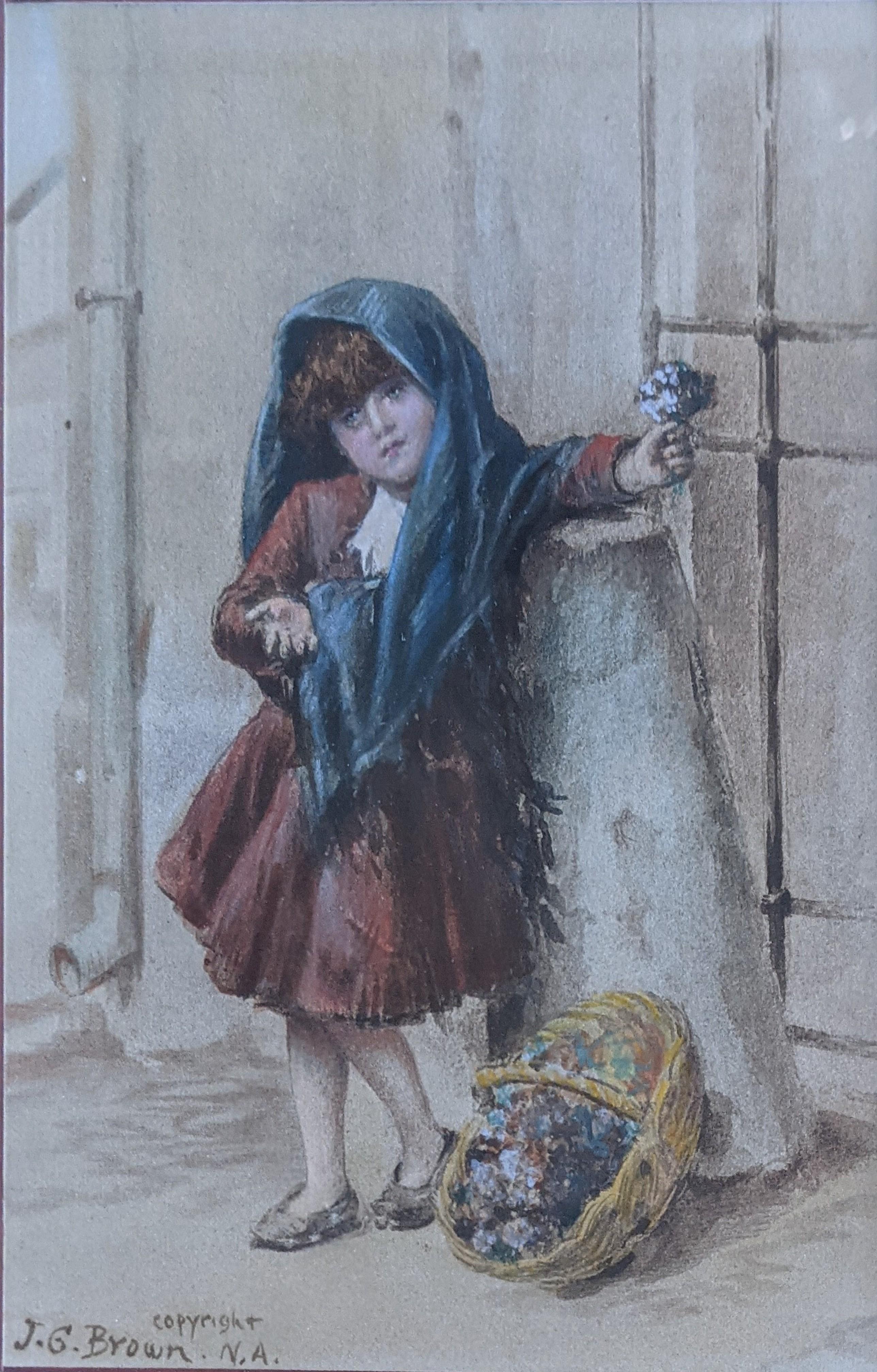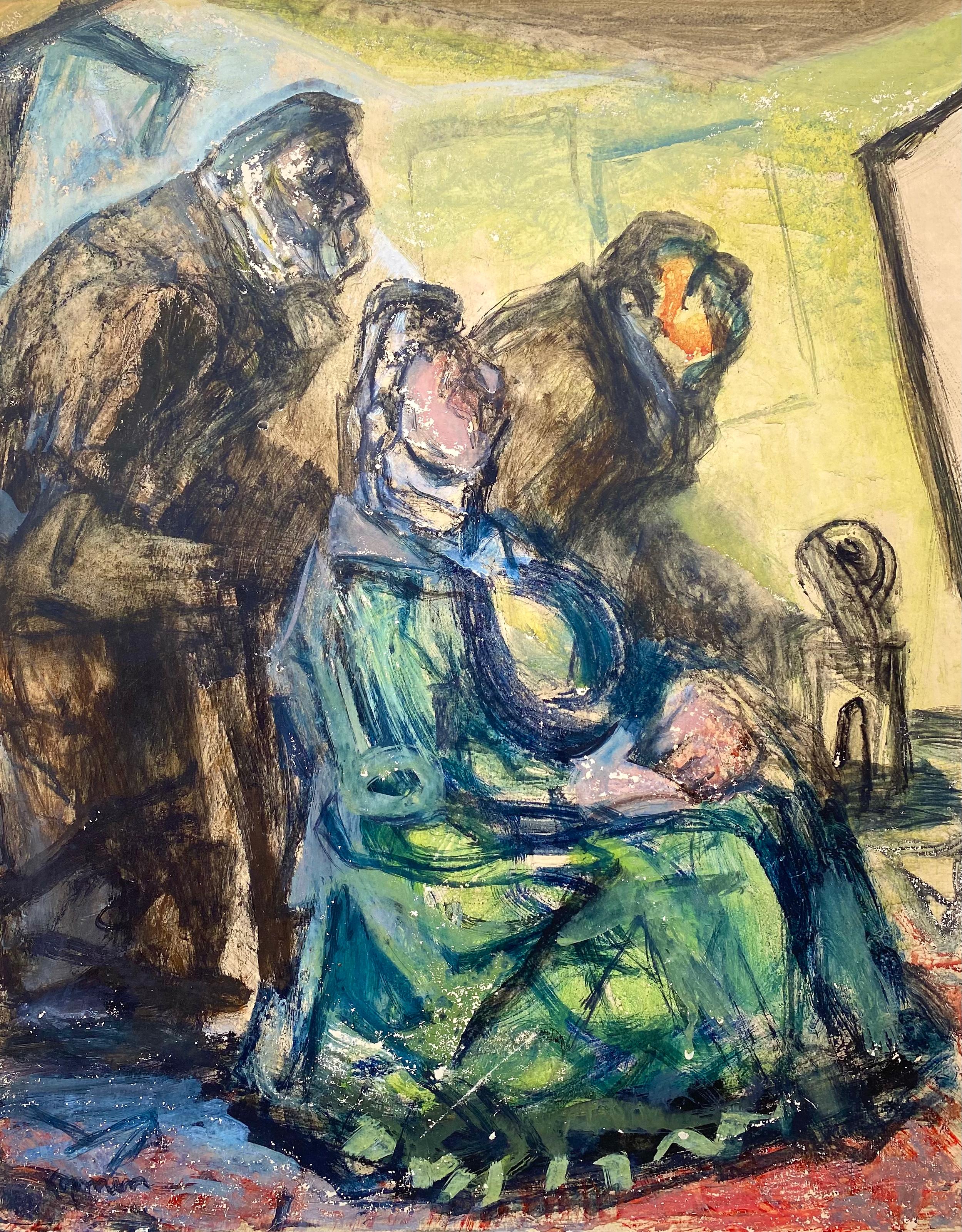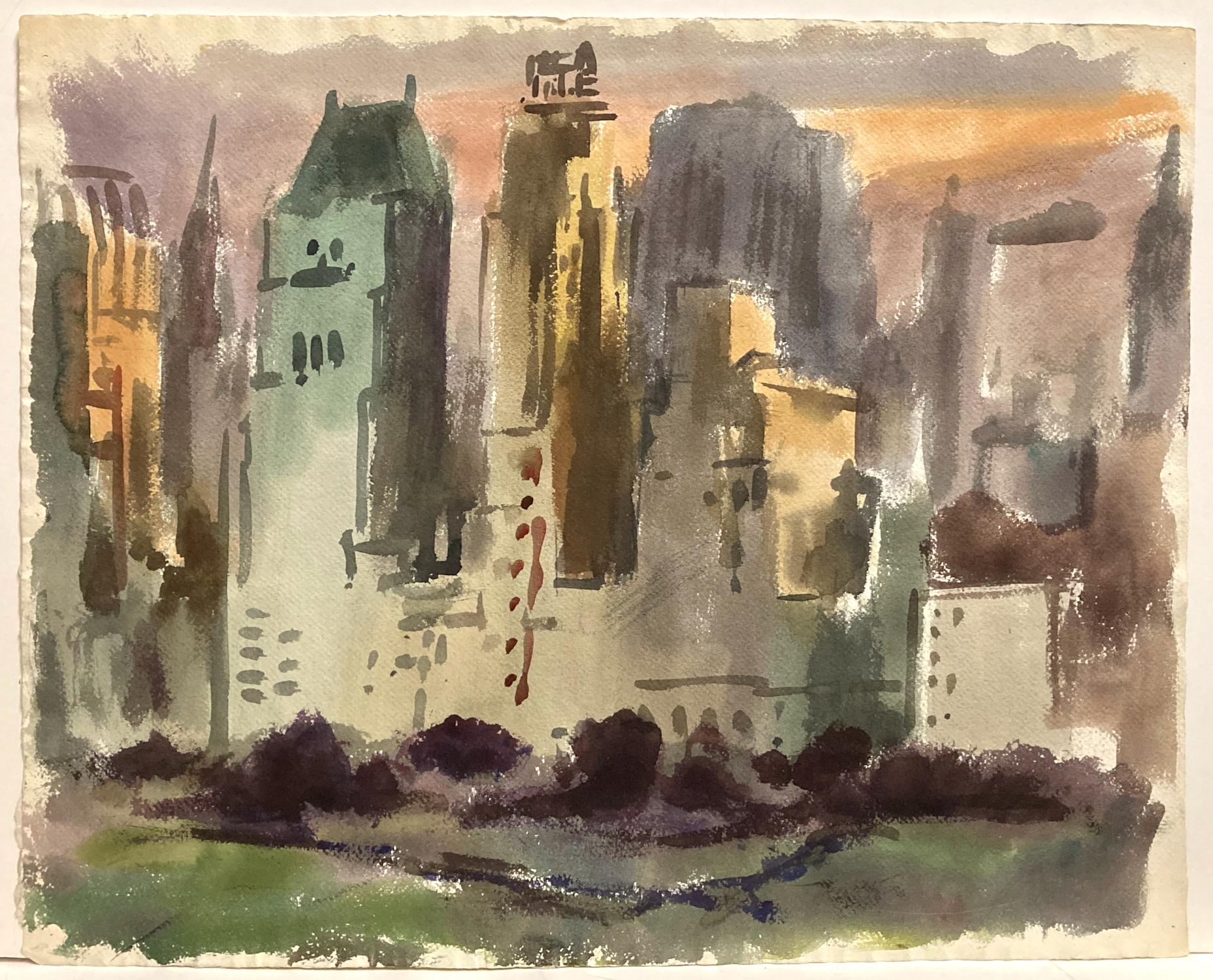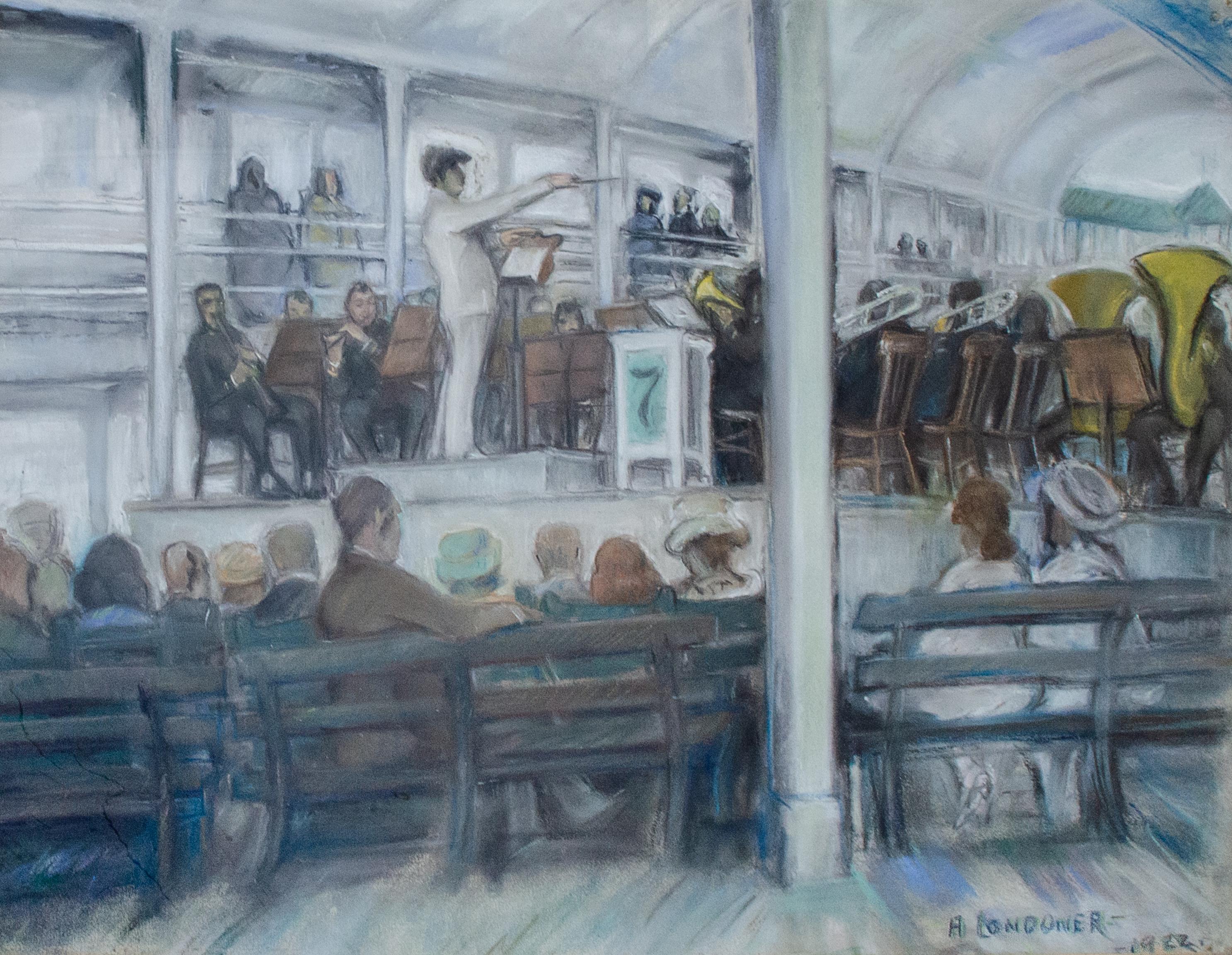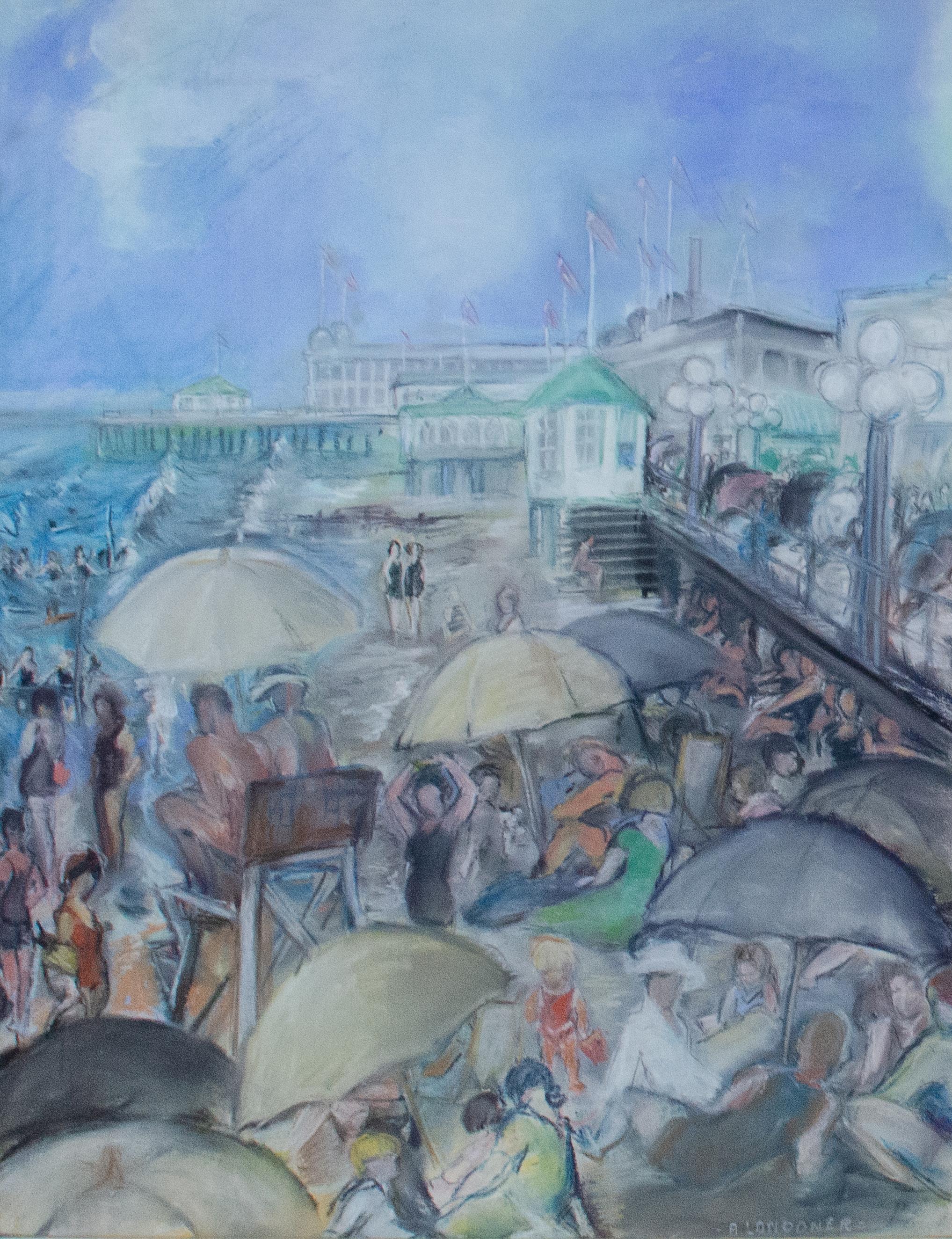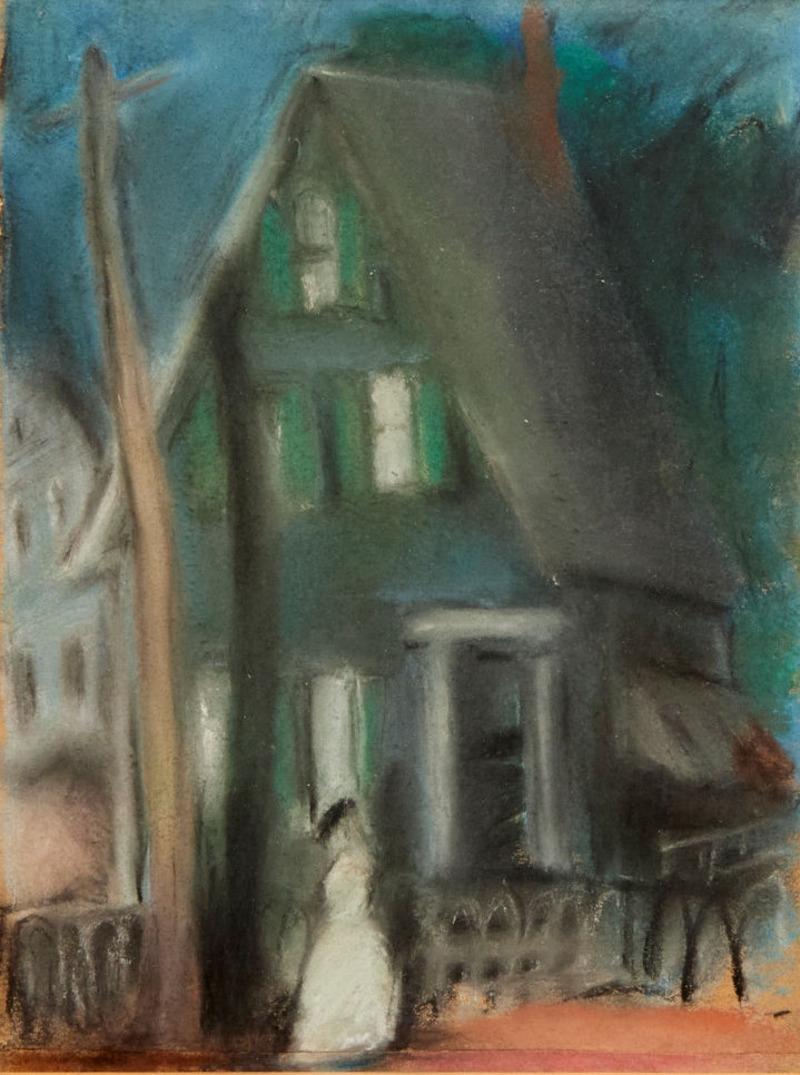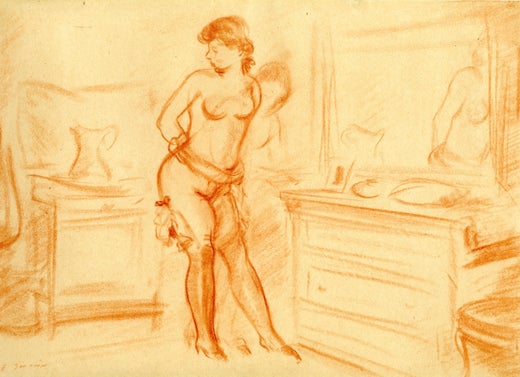Items Similar to "Reclining Nude" Everett Shinn, Figurative Woman Watercolor, Ashcan School
Want more images or videos?
Request additional images or videos from the seller
1 of 11
Everett Shinn"Reclining Nude" Everett Shinn, Figurative Woman Watercolor, Ashcan School1940
1940
About the Item
Everett Shinn
Reclining Nude, 1940
Signed and dated lower left
Watercolor on paper
4 1/2 x 9 inches
Provenance:
Christie's New York, Interiors, August 28, 2012, Lot 181
Private Collection
Everett Shinn, a future member of the Eight and remarkable, rather theatrical personality was born at Woodstown, New Jersey in 1873. Even more recent sources give 1876 as the year of Everett Shinn's birth but the artist usually lied about his age to appear younger than he actually was. Edith DeShazo claimed that information from family members established the date of November 6, 1876 as Shinn's birthday. But if this is true, he would have enrolled at the Spring Garden Institute in Philadelphia to study industrial art at the age of twelve. Born to a Quaker named Isaiah Conklin Shinn and Josephine Ransley Shinn, Everett was their third child. He enjoyed a happy childhood as an undisciplined boy fond of sweets, acrobatics, and the circus.
Shinn opted for the Pennsylvania Academy of the Fine Arts for instruction in the fall of 1893, and began as a staff artist for the Philadelphia Press. At that time William Glackens was working there as well, while John Sloan was at the Inquirer. A year later, Glackens was at the Press, and also, in 1894, George Luks joined the staff there. As DeShazo explained, "the Press art department became a meeting place for men both on the staff and off with similar artistic and literary interests." Members of the same group also met at Robert Henri's studio. By 1897, Shinn was in New York, working for the New York World where Luks had been for about a year. The rest of the "Philadelphia Four" would follow them before long.
Shinn spent much of 1898 hounding the offices of Harper's until finally, the editor and publisher, Colonel George Harvey saw his portfolio, then commissioned a view of the Old Metropolitan Opera House in a snowstorm. The pastel appeared about a year later in the February 17th issue of Harper's Weekly, in 1900. Meanwhile, Shinn kept busy with decorative work (murals, screens, and door panels) at private residences and even in Trenton, New Jersey's City Hall. In 1899, the Boussod-Valadon Galleries gave Shinn his first one-man show. He continued to carry out commissions for illustrations. Shinn began exhibiting at the Pennsylvania Academy (1899-1908) and at the Art Institute of Chicago (1903-43).
A trip to Europe is documented in 1900 by an exhibition at Goupil's in Paris and by various drawings of Paris and London but nothing more appears to be known about where Shinn went or what he saw, except that he was in Paris in July. Undoubtedly, he would have seen the art at the Paris Universal Exposition. DeShazo noted that after having returned to America, Shinn lost interest in lower class urban life, and Young pointed out that unlike most members of the Eight, Shinn was not attracted to art focused on "people sleeping under bridges." In fact, he loved the glamor of Uptown, fashionably dressed ladies, and above all, Shinn wanted to depict the excitement of the theater. He himself was an amateur playwright. Shinn used spatial devices that Degas had initiated earlier but as Young rightly observed, Jean-Louis Forain (1852-1931) is a more accurate source for Shinn's chic theatrical pieces, dancers, and cabaret scenes. Théophile Steinlen (1859-1901) was another artist popular with the Philadelphia artist-reporters group, as Ferber noted.
Shinn was not part of the National Arts Club exhibition of works by future members of the Eight in 1904, but he was mentioned by Gallatin in 1906 as a kind of American Degas. The author praised Shinn's draftsmanship and the technique of his pastels: "Very real they are: we might almost imagine ourselves looking in upon the actual scene." Shinn did take part in Macbeth Galleries' famous show four years later. He exhibited eight works, including The Hippodrome, London (Art Institute of Chicago), The White Ballet, ca. 1905, and The Orchestra Pit (both: collection of Mr. and Mrs. Arthur G. Altschul). One of his works sold, a painting now called Revue (Whitney Museum of American Art), formerly titled Girl in Blue. Shinn also participated in the Exhibition of Independent Artists in 1910 and finished the murals in Trenton in the following year. Milton Brown regarded these depictions by Shinn of pottery kilns and steel mills as "important . . . in that they treated a contemporary industrial subject rather than an historical or allegorical scene."
Shinn was invited but refused to exhibit in the 1913 Armory Show. In fact, at that time, he was working on neo-Rococo decorative panels in private residences. Not much has been written on Shinn's activities between 1920 and 1940. He did not exhibit often but continued to work as an illustrator. In the 1940s, Shinn was represented by Ferargil Galleries. He contributed "Recollections of The Eight," an essay in the Brooklyn Museum's catalogue of the exhibition The Eight, which opened on 24 November 1943. The rather monochromatic Washington Square (Addison Gallery of American Art) is a late work, from around 1945. Shinn, who died in New York City on May 1, 1953, managed to outlive all other members of the Eight. Unfortunately for us all, a thorough, scholarly monograph on the artist remains to be written. Shinn showed the impressionists' love of contemporary subject matter and painted in a spontaneous, non-academic manner. In fact, critics seem to agree that Shinn's facility was his downfall. On the other hand, he maintained visual and narrative clarity, as his penchant toward illustration prevailed.
- Creator:Everett Shinn (1876-1953, American)
- Creation Year:1940
- Dimensions:Height: 15 in (38.1 cm)Width: 19 in (48.26 cm)
- Medium:
- Movement & Style:
- Period:
- Condition:
- Gallery Location:New York, NY
- Reference Number:1stDibs: LU1841213461772
Everett Shinn
Everett Shinn, a future member of the Eight and remarkable, rather theatrical personality was born at Woodstown, New Jersey in 1873. Even more recent sources give 1876 as the year of Everett Shinn's birth (Zurier, Snyder, and Mecklenburg, 1995, p. 224) but the artist usually lied about his age to appear younger than he actually was. Edith DeShazo (1974, errata sheet) claimed that information from family members established the date of November 6, 1876 as Shinn's birthday. But if this is true, he would have enrolled at the Spring Garden Institute in Philadelphia to study industrial art at the age of twelve. Born to a Quaker named Isaiah Conklin Shinn and Josephine Ransley Shinn, Everett was their third child. He enjoyed a happy childhood as an undisciplined boy fond of sweets, acrobatics, and the circus (DeShazo, 1974, pp. 15-17). Shinn opted for the Pennsylvania Academy of the Fine Arts for instruction in the fall of 1893, and began as a staff artist for the Philadelphia Press. At that time William Glackens was working there as well, while John Sloan was at the Inquirer. A year later, Glackens was at the Press, and also, in 1894, George Luks joined the staff there. As DeShazo explained (1974, p. 29), "the Press art department became a meeting place for men both on the staff and off with similar artistic and literary interests." Members of the same group also met at Robert Henri's studio. By 1897, Shinn was in New York, working for the New York World where Luks had been for about a year. The rest of the "Philadelphia Four" (artist-reporters) would follow them before long. Shinn spent much of 1898 hounding the offices of Harper's until finally, the editor and publisher, Colonel George Harvey saw his portfolio, then commissioned a view of the Old Metropolitan Opera House in a snowstorm. The pastel appeared about a year later in the February 17th issue of Harper's Weekly, in 1900. Meanwhile, Shinn kept busy with decorative work (murals, screens, and door panels) at private residences and even in Trenton, New Jersey's City Hall. In 1899, the Boussod-Valadon Galleries gave Shinn his first one-man show. He continued to carry out commissions for illustrations (see Bullard, 1968). Shinn began exhibiting at the Pennsylvania Academy (1899-1908) and at the Art Institute of Chicago (1903-43).
About the Seller
5.0
Platinum Seller
These expertly vetted sellers are 1stDibs' most experienced sellers and are rated highest by our customers.
Established in 2021
1stDibs seller since 2022
63 sales on 1stDibs
Typical response time: <1 hour
- ShippingRetrieving quote...Ships From: New York, NY
- Return PolicyA return for this item may be initiated within 3 days of delivery.
More From This SellerView All
- "Flower Girl, " John George Brown, Genre Painting, Street FigureBy John George BrownLocated in New York, NYJohn George Brown (1831 - 1913) Flower Girl, circa 1900 Watercolor on paper 6 3/4 x 4 3/4 inches Signed lower left Period Hand Carved Foster Brothers Fram...Category
Early 1900s Ashcan School Figurative Paintings
MaterialsPaper, Watercolor
- "Musical Conductor" Amy Londoner, Ashcan School, Figurative Concert SceneBy Amy LondonerLocated in New York, NYAmy Londoner Musical Conductor, 1922 Signed and dated lower right Pastel on paper Sight 18 x 23 inches Amy Londoner (April 12, 1875 – 1951) was an American painter who exhibited at ...Category
1920s Ashcan School Figurative Paintings
MaterialsPastel, Paper
- "Beach at Atlantic City, New Jersey" Amy Londoner, Ashcan School, FigurativeBy Amy LondonerLocated in New York, NYAmy Londoner Beach at Atlantic City, circa 1922 Signed lower right Pastel on paper Sight 23 x 18 inches Amy Londoner (April 12, 1875 – 1951) was an American painter who exhibited at...Category
1920s Ashcan School Figurative Paintings
MaterialsPastel, Paper
- "Night Stroll" Amy Londoner, Ashcan School, Figurative NocturneBy Amy LondonerLocated in New York, NYAmy Londoner Beach at Atlantic City, circa 1922 Signed lower right Pastel on paper Sight 23 x 18 inches Amy Londoner (April 12, 1875 – 1951) was an American painter who exhibited at...Category
1910s Ashcan School Figurative Paintings
MaterialsPastel, Paper
- "Zapotecan" Marion Greenwood, Indigenous Mexican Figurative WatercolorBy Marion GreenwoodLocated in New York, NYMarion Greenwood Zapotecan, 1956 Signed and dated Watercolor on paper 12 1/4 x 9 5/8 inches Provenance: Milch Galleries, New York Marion Greenwood, a painter and printmaker, was bo...Category
1950s Figurative Drawings and Watercolors
MaterialsPaper, Watercolor
- "Lobstermen in Gloucester, Mass." Lionel Reiss WPA Social Realism FishermenBy Lionel S. ReissLocated in New York, NYLionel S. Reiss (1894 - 1988) Lobstermen in Gloucester, Massachusetts, circa 1943 Watercolor on paper Sight 17 1/2 x 23 inches Signed lower left Provenance: Private Collection, Las Vegas, Nevada In describing his own style, Lionel Reiss wrote, “By nature, inclination, and training, I have long since recognized the fact that...I belong to the category of those who can only gladly affirm the reality of the world I live in.” Reiss’s subject matter was wide-ranging, including gritty New York scenes, landscapes of bucolic Bucks County, Pennsylvania, and seascapes around Gloucester, Massachusetts. However, it was as a painter of Jewish life—both in Israel and in Europe before World War II—that Reiss excelled. I.B. Singer, the Nobel Prize winner for Literature, noted that Reiss was “essentially an artist of the nineteenth century, and because of this he had the power and the courage to tell visually the story of a people.” Although Reiss was born in Jaroslaw, Poland, his family immigrated to the United States in 1898 when he was four years old. Reiss's family settled on New York City’s Lower East Side and he lived in the city for most of his life. Reiss attended the Art Students League and then worked as a commercial artist for newspapers and publishers. As art director for Metro-Goldwyn-Mayer, he supposedly created the studio’s famous lion logo. After World War I, Reiss became fascinated with Jewish life in the ‘Old World.’ In 1921 he left his advertising work and spent the next ten years traveling in Europe, the Middle East, and North Africa. Like noted Jewish photographers Alter Kacyzne and Roman Vishniac, Reiss depicted Jewish life in Poland prior to World War II. He later wrote, “My trip encompassed three main objectives: to make ethnic studies of Jewish types wherever I traveled; to paint and draw Jewish life, as I saw it and felt it, in all aspects; and to round out my work in Israel.” In Europe, Reiss recorded quotidian scenes in a variety of media and different settings such as Paris, Amsterdam, the Venice ghetto, the Jewish cemetery in Prague, and an array of shops, synagogues, streets, and marketplaces in the Jewish quarters of Warsaw, Lodz, Krakow, Lublin, Vilna, Ternopil, and Kovno. He paid great attention to details of dress, hair, and facial features, and his work became noted for its descriptive quality. A selection of Reiss’s portraits appeared in 1938 in his book My Models Were Jews. In this book, published on the eve of the Holocaust, Reiss argued that there was “no such thing as a ‘Jewish race’.” Instead, he claimed that the Jewish people were a cultural group with a great deal of diversity within and between Jewish communities around the world. Franz Boas...Category
1940s American Realist Landscape Paintings
MaterialsPaper, Watercolor
You May Also Like
- ”Admiring the Picture”By Benjamin KopmanLocated in Southampton, NYVery well executed original gouache on archival paper by the well known American artist Benjamin Kopman. The scene depicts three figures admiring a picture. Signed lower left. Circa ...Category
1930s Ashcan School Figurative Drawings and Watercolors
MaterialsGouache, Archival Paper
- James Penney, New York From Central ParkBy James PenneyLocated in New York, NYJames Penney was widely known for his New Yorker covers as well as his paintings and prints. Penney was from Saint Joseph, Missouri. He trained i...Category
Mid-20th Century Ashcan School Landscape Drawings and Watercolors
MaterialsWatercolor
- A Pair of Framed Monkey StudiesBy Alexander Oscar LevyLocated in Buffalo, NYA pair of exquisite drawings by American Ashcan School artist Alexander Oscar Levy.Category
1920s Ashcan School Animal Drawings and Watercolors
MaterialsGraphite, Archival Paper
- Third Man 2, black and white, night scene, cityscapeBy Tom BennettLocated in Brooklyn, NYDramatic imagery from FILM NOIR series of black and white monotypes, blending surreal mindscapes with stark realism About Tom Bennett: With quick brushstrokes, Tom Bennett creates r...Category
2010s Ashcan School Figurative Drawings and Watercolors
MaterialsMonotype, Archival Paper
- Otis Skinner as Col. Philippe Bridau in "The Honor of the Family"By George Benjamin LuksLocated in Concord, MAGEORGE LUKS (1867-1933) Otis Skinner as Col. Philippe Bridau in "The Honor of the Family", c. 1919 Charcoal on paper 12 x 7 ¾ inches (sight) Signed at lo...Category
1910s Ashcan School Figurative Drawings and Watercolors
MaterialsPaper, Charcoal
- Head Study, 1930By John SloanLocated in Missouri, MOHead Study, 1930 John Sloan (1871-1951) Signed Lower Right 10.5" x 9" Unframed 19" x 16.5" Framed Born in Lock Haven, Pennsylvania, John Sloan became one o...Category
Early 20th Century Ashcan School Portrait Drawings and Watercolors
MaterialsConté, Paper
